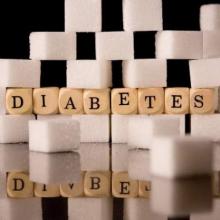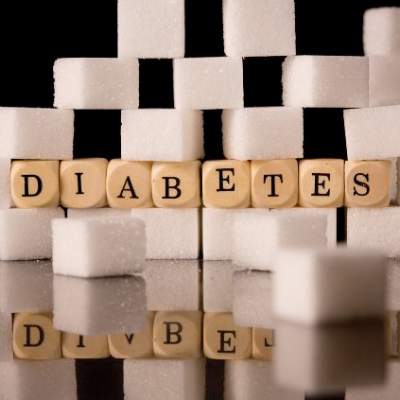User login
For adults whose type 2 diabetes is not controlled by glargine plus metformin, switching from glargine to combination degludec/liraglutide lowered hemoglobin A1c levels to a noninferior degree, compared with continued uptitrating of glargine, according to a report published online March 1 in JAMA.
In DUAL V, an international, randomized, phase III clinical trial sponsored and conducted by Novo Nordisk, maker of degludec/liraglutide, 557 patients (mean age, 59 years) on a regimen of glargine plus metformin were randomly assigned to switch from glargine to combination degludec/liraglutide or to uptitrate their glargine dose to a target HbA1c level, said Dr. Ildiko Lingvay of the departments of internal medicine and clinical sciences, University of Texas, Dallas, and her associates.
After 26 weeks, HbA1c levels decreased to 6.6% with the study intervention and to 7.1% with the increased glargine. This nonsignificant difference in the primary efficacy endpoint demonstrates the noninferiority of degludec/liraglutide. Combination degludec/liraglutide also was associated with a 1.4-kg reduction in mean body weight to 86.9 kg, while increasing glargine was associated with a 1.8-kg increase in body weight to 89.1 kg.
In addition, hypoglycemic episodes occurred in 28.4% of the degludec/liraglutide group, significantly fewer than the 49.1% of the glargine group who experienced hypoglycemic episodes. The respective rates of hypoglycemic episodes were 2.23 vs. 5.05 per patient-year of exposure to the drugs.
Patients taking degludec/liraglutide reported improved scores on measures of physical health, physical functioning, bodily pain, and the impact of diabetes treatment on daily living, while those taking glargine reported worsening of these scores. Patients in the intervention group also reported higher satisfaction with treatment than did those in the control group, Dr. Lingvay and her associates said (JAMA. 2016 Mar 1. doi: 10.101/jama.2016.1252). The rate of adverse events was 343.3 per 100 person-years of exposure for degludec/liraglutide and 286.4 per 100 person-years for glargine. The respective rates of serious adverse events were 3.9 and 6.7 per 100 person-years of exposure.
“As a once-daily, single injection that is effective, is associated with weight loss, and [carries] a low risk of hypoglycemia, degludec/liraglutide may overcome many of the barriers to treatment intensification in patients treated with basal insulin,” the investigators said.
DUAL V was sponsored by Novo Nordisk, maker of degludec/liraglutide, which also participated in the study design and conduct; the collection, analysis, and interpretation of the data; and the writing of the report. Dr. Lingvay reported ties to Novo Nordisk, Pfizer/Merck, GI Dynamics, AstraZeneca, Boehringer-Ingelheim, Janssen, and Sanofi; her associates reported ties to numerous industry sources.
For adults whose type 2 diabetes is not controlled by glargine plus metformin, switching from glargine to combination degludec/liraglutide lowered hemoglobin A1c levels to a noninferior degree, compared with continued uptitrating of glargine, according to a report published online March 1 in JAMA.
In DUAL V, an international, randomized, phase III clinical trial sponsored and conducted by Novo Nordisk, maker of degludec/liraglutide, 557 patients (mean age, 59 years) on a regimen of glargine plus metformin were randomly assigned to switch from glargine to combination degludec/liraglutide or to uptitrate their glargine dose to a target HbA1c level, said Dr. Ildiko Lingvay of the departments of internal medicine and clinical sciences, University of Texas, Dallas, and her associates.
After 26 weeks, HbA1c levels decreased to 6.6% with the study intervention and to 7.1% with the increased glargine. This nonsignificant difference in the primary efficacy endpoint demonstrates the noninferiority of degludec/liraglutide. Combination degludec/liraglutide also was associated with a 1.4-kg reduction in mean body weight to 86.9 kg, while increasing glargine was associated with a 1.8-kg increase in body weight to 89.1 kg.
In addition, hypoglycemic episodes occurred in 28.4% of the degludec/liraglutide group, significantly fewer than the 49.1% of the glargine group who experienced hypoglycemic episodes. The respective rates of hypoglycemic episodes were 2.23 vs. 5.05 per patient-year of exposure to the drugs.
Patients taking degludec/liraglutide reported improved scores on measures of physical health, physical functioning, bodily pain, and the impact of diabetes treatment on daily living, while those taking glargine reported worsening of these scores. Patients in the intervention group also reported higher satisfaction with treatment than did those in the control group, Dr. Lingvay and her associates said (JAMA. 2016 Mar 1. doi: 10.101/jama.2016.1252). The rate of adverse events was 343.3 per 100 person-years of exposure for degludec/liraglutide and 286.4 per 100 person-years for glargine. The respective rates of serious adverse events were 3.9 and 6.7 per 100 person-years of exposure.
“As a once-daily, single injection that is effective, is associated with weight loss, and [carries] a low risk of hypoglycemia, degludec/liraglutide may overcome many of the barriers to treatment intensification in patients treated with basal insulin,” the investigators said.
DUAL V was sponsored by Novo Nordisk, maker of degludec/liraglutide, which also participated in the study design and conduct; the collection, analysis, and interpretation of the data; and the writing of the report. Dr. Lingvay reported ties to Novo Nordisk, Pfizer/Merck, GI Dynamics, AstraZeneca, Boehringer-Ingelheim, Janssen, and Sanofi; her associates reported ties to numerous industry sources.
For adults whose type 2 diabetes is not controlled by glargine plus metformin, switching from glargine to combination degludec/liraglutide lowered hemoglobin A1c levels to a noninferior degree, compared with continued uptitrating of glargine, according to a report published online March 1 in JAMA.
In DUAL V, an international, randomized, phase III clinical trial sponsored and conducted by Novo Nordisk, maker of degludec/liraglutide, 557 patients (mean age, 59 years) on a regimen of glargine plus metformin were randomly assigned to switch from glargine to combination degludec/liraglutide or to uptitrate their glargine dose to a target HbA1c level, said Dr. Ildiko Lingvay of the departments of internal medicine and clinical sciences, University of Texas, Dallas, and her associates.
After 26 weeks, HbA1c levels decreased to 6.6% with the study intervention and to 7.1% with the increased glargine. This nonsignificant difference in the primary efficacy endpoint demonstrates the noninferiority of degludec/liraglutide. Combination degludec/liraglutide also was associated with a 1.4-kg reduction in mean body weight to 86.9 kg, while increasing glargine was associated with a 1.8-kg increase in body weight to 89.1 kg.
In addition, hypoglycemic episodes occurred in 28.4% of the degludec/liraglutide group, significantly fewer than the 49.1% of the glargine group who experienced hypoglycemic episodes. The respective rates of hypoglycemic episodes were 2.23 vs. 5.05 per patient-year of exposure to the drugs.
Patients taking degludec/liraglutide reported improved scores on measures of physical health, physical functioning, bodily pain, and the impact of diabetes treatment on daily living, while those taking glargine reported worsening of these scores. Patients in the intervention group also reported higher satisfaction with treatment than did those in the control group, Dr. Lingvay and her associates said (JAMA. 2016 Mar 1. doi: 10.101/jama.2016.1252). The rate of adverse events was 343.3 per 100 person-years of exposure for degludec/liraglutide and 286.4 per 100 person-years for glargine. The respective rates of serious adverse events were 3.9 and 6.7 per 100 person-years of exposure.
“As a once-daily, single injection that is effective, is associated with weight loss, and [carries] a low risk of hypoglycemia, degludec/liraglutide may overcome many of the barriers to treatment intensification in patients treated with basal insulin,” the investigators said.
DUAL V was sponsored by Novo Nordisk, maker of degludec/liraglutide, which also participated in the study design and conduct; the collection, analysis, and interpretation of the data; and the writing of the report. Dr. Lingvay reported ties to Novo Nordisk, Pfizer/Merck, GI Dynamics, AstraZeneca, Boehringer-Ingelheim, Janssen, and Sanofi; her associates reported ties to numerous industry sources.
FROM JAMA
Key clinical point: Switching to combination degludec/liraglutide produced noninferior reductions in HbA1c levels in adults with uncontrolled type 2 diabetes, compared with continued uptitrating of glargine.
Major finding: After 26 weeks, mean HbA1c levels decreased to 6.6% with degludec/liraglutide and to 7.1% with increased glargine, a nonsignificant difference.
Data source: DUAL V, an international, randomized, phase III noninferiority trial in 557 adults with uncontrolled type 2 diabetes treated for 26 weeks.
Disclosures: DUAL V was sponsored by Novo Nordisk, maker of degludec/liraglutide, which also participated in the study design and conduct; the collection, analysis, and interpretation of the data; and the writing of the report. Dr. Lingvay reported ties to Novo Nordisk, Pfizer/Merck, GI Dynamics, AstraZeneca, Boehringer-Ingelheim, Janssen, and Sanofi; her associates reported ties to numerous industry sources.

